Terry Spivey, USDA Forest Service, Bugwood.org
Whether the thought of an encounter with a black bear is thrilling to you, or perhaps a bit unnerving, there is no denying that the possibility of meeting this large ursine in Connecticut is growing every year. The black bear (Ursus americanus) was extirpated from our state in the mid-nineteenth century. But as farmlands were abandoned and allowed to revert back to the forested habitat that bears require, these big mammals have made a comeback. What began as a slow movement of bears to Connecticut from neighboring states has evolved into a resident population that breeds successfully in our forests. Since the 1980s bear sightings have increased dramatically throughout Connecticut, and it is estimated that several hundred black bears now reside here. Though most are found in the northwest corner of the state, several sightings have occurred in our area.
An adult male black bear, or boar, weighs between 150 and 400 pounds and, when standing on its hind legs, can measure up to six feet tall. When on all fours it will reach about three and a half feet tall at the shoulders. The female, or sow, is smaller and weighs between 110 and 200 pounds. The bear’s thick coat is black or dark brown and its muzzle is tan. Occasionally, a small white patch can be seen on the chest.
Harvey Barrison, CC BY-SA 2.0
Mature forests with various tree species that produce mast (such as acorns and beechnuts) are the bear’s preferred habitats in the fall. Wetlands provide vital food in the early spring when emerging aquatic plants are some of the first available foods after a winter spent hibernating. The black bear is an omnivore and will readily eat grasses, fruits and berries, ants, bees, honey, and occasionally small mammals. It will scavenge carrion, such as a deer carcass, but is also an opportunist. Garbage cans, pet food dishes, bird feeders, and livestock can and do attract bears to human dwellings.
Black bears mate in early summer. A sow is usually three or four years old before she mates and has young; she will then bear young every two years. An abundance of acorns in the fall will allow the female to fatten up significantly and can increase the number of young she produces. Typically, two to three cubs are born to a sow, but if she has not eaten well in the fall, she may bear only one cub. On the other hand, if the oaks produced a bumper crop of acorns, the sow might have four cubs.
In Connecticut, black bears enter their hibernation dens in November or December and remain there until March. The bear usually lines the den with plant material or bits of rotten wood. A chosen den site can be as protected as the inside of a brush pile, hollow tree, or rocky crevice, or as exposed as a spot under a fallen tree or among dense vegetation, such as mountain laurel. Bears in exposed dens have been found curled up and asleep with the thick fur on their backs covered with a coating of snow.
Bear hibernation is not considered a true hibernation, like that of the woodchuck, though the bear’s body temperature lowers and its heart rate slows (from 40 to 10 beats per minute) to conserve energy. The bear will not consume any food or water, nor will it urinate or defecate while it remains in its den, but disturbances around the den site can waken a bear from its sleep.
U.S. Fish and Wildlife Service Southeast Region Public Domain
A pregnant female will give birth to her cubs in January or February while she is in her den. The tiny cubs weigh only six6 to 12 ounces when born, and while their mother continues her winter sleep the cubs will nurse and remain active. They will stay with their mother for the next year and a half, denning with her again next winter before each heads out on its female will then be ready to breed again and raise another litter.
The DEEP Wildlife Division has been monitoring bear populations in the state for several years by placing ear tags on bears and attaching radio collars to some. Radio collared females are located while in their winter dens so that biologists can monitor their breeding success. They count, measure and weigh the cubs before returning them to their mother. These studies have shown that black bears are doing remarkably well in our state – and that a chance encounter with a bear becomes more likely with each passing year.
Cindi Kobak


